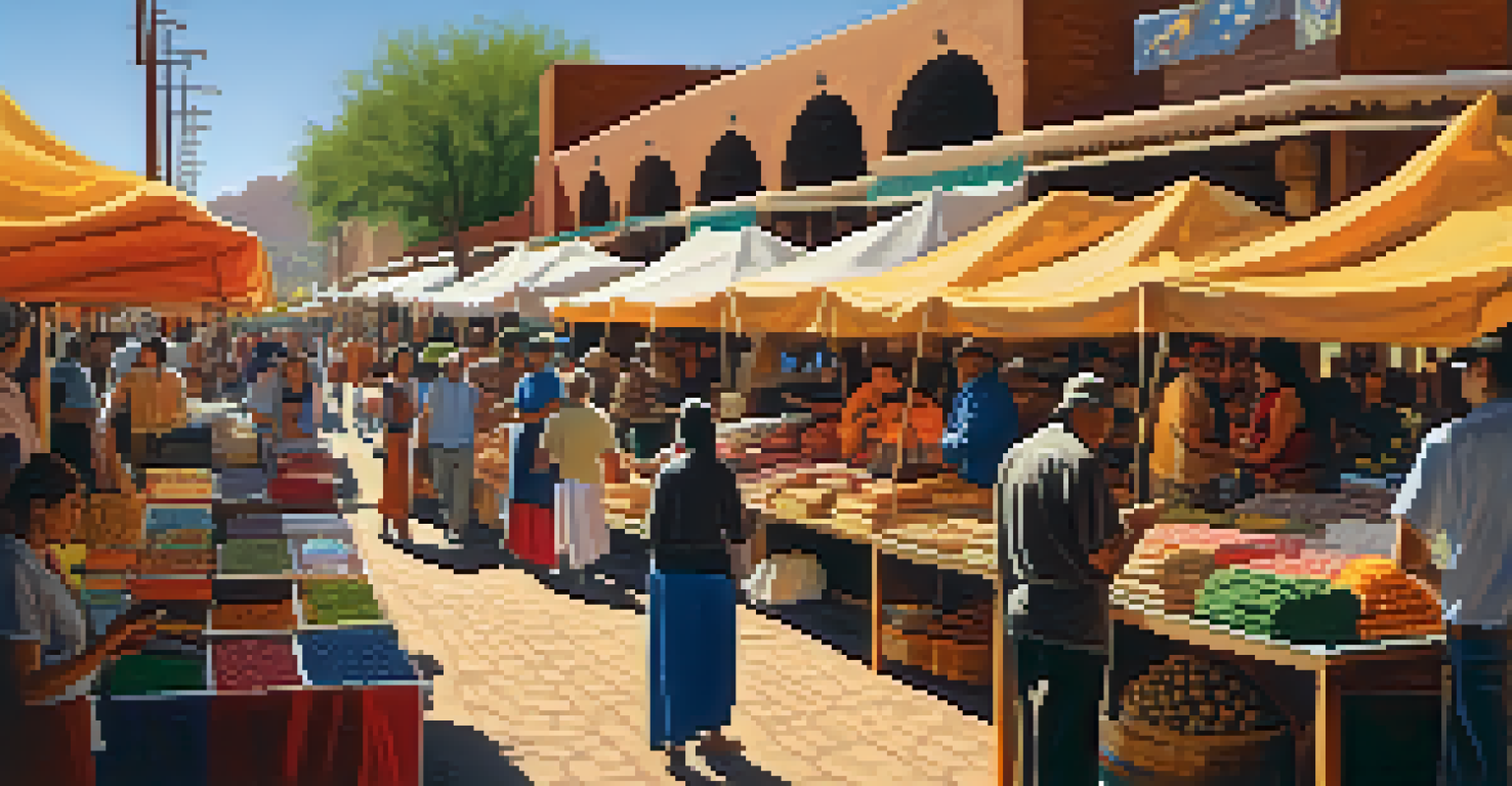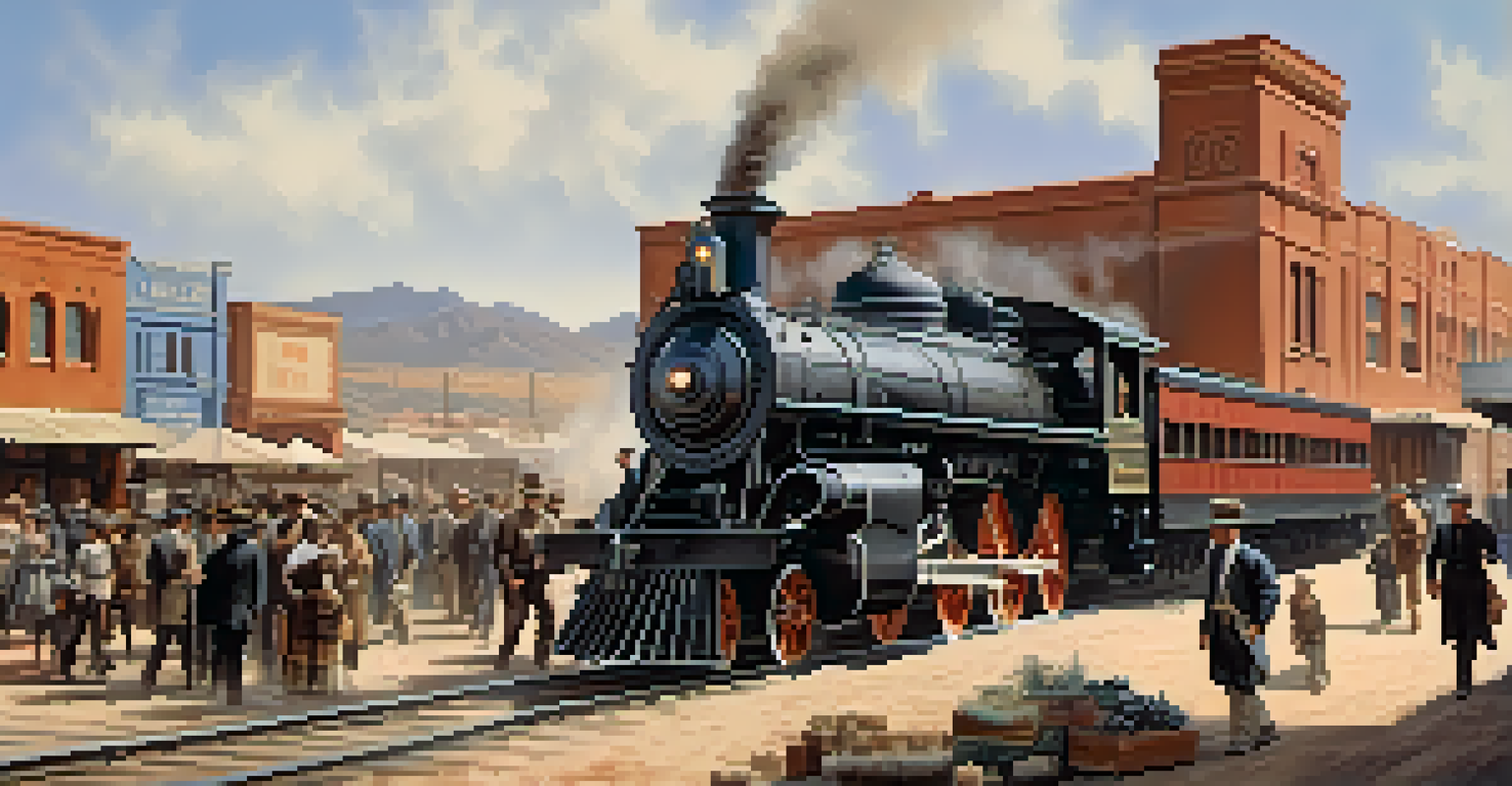The Origins of Tucson as a Trade Hub in the Southwest

The Geographic Advantage of Tucson in Trade
Nestled in the Sonoran Desert, Tucson boasts a unique geographic location that has historically made it a strategic trade hub. Its proximity to Mexico and the natural pathways through the mountains created an ideal setting for commerce. This advantageous positioning allowed Tucson to connect various trade routes, linking it to larger markets both north and south.
Trade is the lifeblood of any economy, connecting cultures and communities across borders.
The Tucson basin, surrounded by mountains, served not only as a point of convergence for different cultures but also as a natural resource hub. The abundant flora and fauna attracted early settlers and traders who recognized the potential for agriculture and trade. This fertile land played a crucial role in establishing Tucson as a center for exchanging goods.
As trade flourished in the region, Tucson became a melting pot of cultures, with Native American, Spanish, and later Anglo influences shaping its development. Each group brought unique goods and traditions, enriching Tucson's trade networks. Thus, the geographic advantage of Tucson set the stage for its emergence as a key player in Southwestern trade.
Indigenous Trade Networks and Their Impact
Long before European settlers arrived, Indigenous peoples established extensive trade networks in the Southwest, with Tucson as a significant hub. Tribes such as the Hohokam and Tohono O'odham traded goods like pottery, textiles, and food across vast distances. These early trade routes laid the groundwork for Tucson's future as a trading center.

The trade practices of these Indigenous communities were sophisticated and relied heavily on seasonal migrations and resource availability. They exchanged items not only for local goods but also for luxury items from distant regions, such as shells from the coast or obsidian from the mountains. This exchange of goods fostered relationships among tribes and highlighted Tucson's importance in the trade landscape.
Tucson's Strategic Trade Location
Situated near Mexico and surrounded by mountains, Tucson has historically served as a vital trade hub connecting various markets.
As European settlers arrived, they built upon these existing networks, often integrating Indigenous knowledge and practices into their own trade activities. The rich history of Indigenous trade in Tucson illustrates the area's longstanding role as a meeting point for diverse cultures, further solidifying its place in the region's economic history.
Spanish Influence and the Expansion of Trade
The arrival of Spanish explorers in the late 17th century marked a new chapter in Tucson's trade history. They recognized the region's potential for agricultural development and established missions that enhanced local trade. These missions not only served religious purposes but also acted as centers for commerce and cultural exchange.
The exchange of goods is not merely a transaction but a bridge between cultures and histories.
Spanish settlers introduced new agricultural products, such as wheat and cattle, which transformed local economies. The establishment of trade routes connecting Tucson to Mexico facilitated the exchange of these goods, leading to increased prosperity in the region. This period saw a blend of Spanish and Indigenous trade practices, creating a vibrant marketplace in Tucson.
As Tucson evolved under Spanish influence, it became a crucial link in the broader trade networks of the Southwest. The incorporation of European goods and practices, along with Indigenous traditions, positioned Tucson as a pivotal location where diverse cultures converged and traded, paving the way for its future as a bustling trade hub.
The Role of the Southern Pacific Railroad
The arrival of the Southern Pacific Railroad in the late 19th century revolutionized trade in Tucson. This transportation breakthrough connected Tucson to larger markets across the United States, allowing goods to flow more freely and efficiently. Suddenly, Tucson was no longer isolated; it became a vital link in national trade routes.
With the railroad came an influx of new businesses and industries, further stimulating the local economy. Goods could be transported quickly, which opened up opportunities for local farmers and artisans to sell their products beyond the immediate area. The railroad transformed Tucson into a bustling hub of commerce, attracting more settlers and traders looking to capitalize on its growing economy.
Cultural Exchange Through Trade
The diverse cultural influences in Tucson, shaped by Indigenous, Spanish, and American traders, enrich the city's identity and community.
This transportation advancement not only changed the economic landscape of Tucson but also its cultural fabric. As people from various backgrounds settled in the area, Tucson became a diverse community where different ideas and practices blended, enhancing its identity as a vibrant trade center in the Southwest.
Tucson’s Role in the Mexican-American Trade
Tucson's proximity to the Mexican border has historically positioned it as a significant player in Mexican-American trade. This relationship has roots in the 19th century when Tucson served as a gateway for goods flowing between the two nations. As trade routes developed, Tucson became a central marketplace for exchanging both local and international products.
The cultural exchange that occurred through this trade was profound, as Tucson became a melting pot of Mexican and American influences. Local markets flourished with a variety of goods, from traditional Mexican crafts to American consumer products. This blend not only enriched the local economy but also fostered a vibrant cultural scene that continues to thrive today.
As the political landscape shifted over the years, Tucson maintained its status as a trading hub, adapting to changes in trade policies and practices. The enduring relationship between Tucson and Mexico highlights the city's role as a bridge between cultures, emphasizing the importance of trade in shaping its unique identity.
Modern Trade and Tucson’s Economic Landscape
Today, Tucson continues to be a vital trade hub, but the nature of trade has evolved significantly. The city has diversified its economy, with sectors like technology, tourism, and international trade playing major roles. This modern economic landscape reflects Tucson's ability to adapt and thrive amid changing circumstances.
The presence of institutions such as the University of Arizona has further enhanced Tucson's appeal as a trade center. Research and innovation drive new business opportunities, creating a dynamic environment for trade and commerce. Tucson's strategic location still offers advantages, making it a prime spot for logistics and distribution.
Modern Economic Diversification
Today, Tucson's economy thrives through technology, tourism, and international trade, reflecting its adaptability and historical trading legacy.
As Tucson moves forward, it remains committed to fostering a vibrant trade community. Initiatives to promote local businesses and encourage international partnerships illustrate the city's dedication to maintaining its historical legacy as a key player in the Southwest's economic landscape.
Cultural Significance of Trade in Tucson’s History
The history of trade in Tucson is not just about commerce; it's also about the cultural exchanges that have shaped the city. Each wave of settlers and traders brought with them unique traditions, foods, and crafts that enriched Tucson's cultural tapestry. This blending of cultures is evident in the city's festivals, cuisine, and art.
For instance, the annual Tucson Folk Festival celebrates the rich musical heritage brought by various cultures, showcasing the diverse influences that have emerged from trade. The local food scene reflects this cultural fusion, with restaurants offering everything from traditional Mexican dishes to contemporary American cuisine, a testament to Tucson's vibrant culinary landscape.

Understanding Tucson's history as a trade hub provides insight into its cultural richness. The city's identity is deeply intertwined with its past, where trade served as a conduit for cultural exchange and community building, highlighting the importance of these relationships in shaping the Tucson we know today.